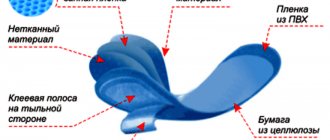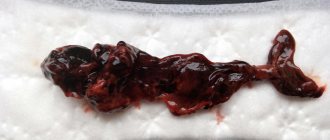Mobiluncus is a conditionally pathogenic microbe that lives in the body of a healthy person and, under certain conditions, causes the development of pathology. A “harmless” microorganism, with a decrease in immune defense and general resistance of the macroorganism, becomes the cause of inflammation of various structures of the urogenital tract.
Infectious and inflammatory diseases of the vagina currently occupy first place among all gynecological pathologies. Most often, their causative agents are bacteria that are representatives of the normal microflora of the vagina. The number of such diseases is steadily growing. This is due to the unfavorable environmental situation, uncontrolled use of antibiotics, poor nutrition, and the frantic pace of life in big cities.
What kind of bacteria is this
Mobiluncus is a mobile vibrio-like microorganism that represents the transient microflora of the genitourinary organs. It is an anaerobe, that is, its growth and reproduction are possible only in the absence of oxygen in the environment. Two species of mobiluncus live in the organs of the genitourinary system - Mobiluncus curtisii and Mobiluncus mulieris. As a rule, the detection of the first type in a smear becomes an alarming factor. In this case, doctors suspect the development of an infectious-inflammatory process, which must be quickly stopped using antibiotics.
Mobiluncus itself is not dangerous, as it is not capable of causing any disease. This is an opportunistic microorganism that constantly lives in the vagina. If its population does not exceed the norm, then the woman does not experience any discomfort. But even a slight weakening of the immune system leads to active proliferation of mobiluncus. Now it is no longer a conditionally pathogenic microorganism, but an infectious agent.
Mobiluncus (mobiluncus)
| Mobiluncus |
Mobiluncus
(
Mobiluncu
s) is a genus of facultative anaerobic rod-shaped motile bacteria. Opportunistic human microflora. The causative agent of vaginosis and vaginitis in women and urethritis and prostatitis in men.
Mobiluncus in the taxonomy of bacteria
Formerly Mobiluncus
was called
Falcivibrio
and was included in the family
Bifidobacteriaceae
.
This genus was later reclassified, renamed and included in the family Actinomycetaceae
.
The latter is included in the order Actinomycetales
, class
Actinobacteria
, phylum
Actinobacteria
,
Terrabacteria group
, kingdom Bacteria.
The genus includes two species: Mobiluncus curtisii
(formerly called
Falcivibrio vaginalis
) and
Mobiluncus mulieris
(formerly
Falcivibrio grandis
).
of Mobiluncus curtisii
is considered to be significantly greater than that
of Mobiluncus mulieris
.
Bacteria of the genus Mobiluncus and diseases of the urogenital tract
Mobiluncus curtisii
stands out in women with a clinical diagnosis of bacterial vaginosis in 47.1%, of which in the form of a monoinfection in 52%, acute endometritis - 5.2%, acute salpingoophoritis - 11.4%, and in men with a clinical diagnosis of acute urethritis in 21, 5%, acute prostatitis - 12.2%, acute orchiepididymitis - 5.3% and in other conditions (frozen pregnancy, acute vesiculitis, etc.) in 0.84%.
Thus, Mobiluncus curtisii
is one of the most common microorganisms that can cause infectious and inflammatory diseases of the urogenital tract in both women and men (Aminev R.A. et al.).
Mobiluncus
in bacterial vaginosis it is often associated with
Gardnerella vaginalis
and bacteroides.
Bacteria of the genus Mobiluncus
are isolated only in 5% of healthy women, and
Mobiluncus mulieris
is more common in healthy women than
Mobiluncus curtisii
.
Mobiluncus have the ability to attach to vaginal epithelial cells. Mucolytic enzymes were found in them: mucinase, neuraminidase. An increase in the activity of these enzymes in vaginal secretions can lead to rupture of the membranes and premature birth (Kafarskaya L.I. et al.).
Sensitivity of Mobiluncus to antimicrobial agents
M. curtisii
and
M. mulieris
are sensitive to ampicillin, cephalosporins, clindamycin, erythromycin, vancomycin, azithromycin and resistant to metronidazole (MIC90=256 μg/ml).
Source
Why are they activated?
95% of vaginal microflora are lactobacilli - antagonists of opportunistic and pathogenic bacteria. Under their influence, the correct course of metabolic processes occurs and immunity is maintained at the proper level. Once even a small part of lactobacilli is killed, staphylococci, enteropathogenic Escherichia coli, and Proteus begin to grow and multiply in the vacant space. The Mobiluncus population is also increasing.
A decrease in the number of beneficial lactic acid bacteria is especially often provoked by the following factors:
- non-compliance with intimate hygiene rules;
- unbalanced diet;
- consumption of alcoholic beverages;
- hypothermia, including while swimming in bodies of water;
- urolithiasis, chronic cystitis, pyelonephritis;
- endocrine diseases;
- radiation therapy, chemotherapy;
- a course of antibiotics, antifungal or antimicrobial agents.
Mobiluncus is always found in excessive amounts in women with STIs, for example, gonorrhea, syphilis, as well as mycoplasmosis, chlamydia, and ureaplasmosis. Natural reasons for the increase in its population include natural menopause. During menopause, the vaginal mucosa does not retain moisture so well, which leads to microtrauma. And this is a favorable environment for the proliferation of opportunistic microorganisms.
Attention: During pregnancy, an increase in the number of mobiluncus is caused by frequent hormonal fluctuations, changed eating habits, and hemodynamic changes. Its timely detection in a smear and treatment allows you to prevent the development of infection.
Does my husband (sexual partner) need treatment?
According to statistics, in the majority of the male population whose sexual partners were exposed to the disease, the main provocateurs of bacterial vaginosis (Gardnerella and other bacilli) were found in the urethra. This may indicate that the bacteria can move from the vagina to the man's urethra during unprotected sex. However, men may not receive treatment. Many studies have demonstrated that therapy with sexual partners does not improve the woman’s condition and the likelihood of a secondary disease does not decrease.
Indications for collecting biomaterial
Detection of mobiluncus in a smear is a unique marker of an infectious and inflammatory process occurring in the genitourinary system. In the vast majority of cases, it indicates the development of bacterial vaginosis. At the initial stage of development of the pathology, there is almost no discomfort. From time to time, a woman is bothered by weak pulling, aching painful sensations in the lower abdomen. But as mobiluncus and other opportunistic microorganisms multiply, the severity of symptoms increases.
Therefore, a smear is taken when a woman complains of one or more signs of bacterial vaginosis:
- burning and itching in the vagina and external genital area;
- thick white discharge, the volume of which usually increases after sexual intercourse;
- redness, swelling of the labia due to inflammation, congestion of blood vessels;
- pain during sexual intercourse;
- increased urge to empty the bladder.
The detection of mobiluncus in a smear is often accompanied by specific signs of an infectious lesion of the genitourinary system
The woman’s general well-being also deteriorates significantly. Anxiety increases, apathy, weakness, fatigue, drowsiness or insomnia, and irritability are noted. During the process of reproduction, mobiluncus and other microbes release their metabolic products into the surrounding space.
With an acute infection, some women develop signs of general intoxication of the body. These are headaches, gastrointestinal disorders, and increased body temperature.
Clinic
A decrease in acidity in the vagina is a necessary condition for the active proliferation of transient microbes that cause local inflammation, as well as its spread by lymphogenous and hematogenous routes to the overlying parts of the genitourinary system: the cervix, uterus, ovaries, fallopian tubes with the development of endometritis, salpingoophoritis, as well as septic conditions .
Bacterial vaginosis caused by Mobiluncus manifests itself with mild clinical symptoms. In patients, the nature of vaginal discharge changes: it becomes abundant, grayish, but remains homogeneous, without lumps or grains. Women complain of discomfort, itching and burning in the vagina, dysuria, pain during sexual intercourse. When the disease becomes severely chronic, the well-being of patients deteriorates sharply. Vaginal discharge thickens, becomes viscous and sticky, yellow-green, slightly foaming and unpleasantly smelling. Mobiluncus often causes menstrual irregularities and the appearance of mucus and pus in the blood. During the examination, gynecologists note signs of vaginal inflammation - irritation, swelling and redness of the vaginal mucosa.
Mobiluncus is a specific microbe for bacterial vaginosis. The disease caused by it is usually asymptomatic and cannot be treated for a long time. This leads to chronicization of the process and the development of severe complications. The infection becomes recurrent, and inflammation gradually spreads to the pelvic organs.
In men, the infection does not manifest itself clinically, since in most cases they are carriers of the bacteria. It is possible to develop chronic urethra, prostatitis or vesiculitis, which proceed torpidly, with very scanty discharge, dysuric disorders, hyperemia and swelling of the external opening of the urethra. Acute forms are extremely rare.
Why is analysis needed?
The presence of mobiluncus in a smear is considered a specific sign of bacterial vaginosis. Therefore, the study is important for diagnosing this pathology, which is asymptomatic. An increase in its population also indicates that a woman has one of the pelvic inflammatory diseases. Doctors immediately prescribe subsequent diagnostic measures to identify the localization of the pathological process, its severity and the cause of its development.
Detection of a large amount of mobiluncus in a smear suggests the presence of an infection, including an STD
And, most importantly, a smear examination helps to avoid complications of bacterial vaginosis through timely treatment. This means premature delivery, increased likelihood of contracting STDs and developing cervical cancer. It also helps prevent the transition of an acute infection into a chronic form that is difficult to treat with antibiotics.
Interesting fact: A characteristic feature of this microorganism is its lack of sensitivity to metronidazole-based drugs. And these are traditional remedies for the treatment of bacterial vaginosis. Detection of mobiluncus allows you to correctly draw up a therapeutic regimen and calculate dosages.
Mobiluncus
All iLive content is reviewed by medical experts to ensure it is as accurate and factual as possible.
We have strict sourcing guidelines and only link to reputable sites, academic research institutions and, where possible, proven medical studies. Please note that the numbers in parentheses ([1], [2], etc.) are clickable links to such studies.
If you believe that any of our content is inaccurate, out of date, or otherwise questionable, please select it and press Ctrl + Enter.
Mobiluncus have fermentative metabolism and are catalase negative. Discharged from the vagina and rectum. They are one of the microbial components involved in the development of bacterial vaginosis.
What influences the results
STI smear
The study data can be distorted by improper preparation or erroneous actions of the doctor or laboratory staff. To ensure accurate results, you need to prepare:
- in the evening, perform genital hygiene without using soap;
- refuse vaginal suppositories, sprays and creams;
- stop taking antibiotics and antifungals;
- do not have sex for two days;
- do not douche;
- refrain from going to the toilet three hours before.
Women should not be tested during their period. The diagnostic procedure is painless; slight discomfort may be observed during the procedure. To avoid it, you need to relax and calm down. Next, the woman sits in a gynecological chair, and the doctor uses a sterile swab or a special instrument to collect contents from three zones: the vaginal mucosa, the cervical canal, and the vagina. Using a broad stroke, he distributes the biomaterial on a glass slide, labels it, and sends it to the laboratory in a special container. If everything is done correctly, the results of the mobiluncus analysis will be informative.
How the research is carried out
Mobiluncus in a smear is detected by two methods - microscopy and PRC. Cultural examination is not practiced, since when biomaterial is sown in a nutrient medium, colonies are formed by almost all microorganisms inhabiting the vagina. Due to the large number of vaginal microflora, enzyme immunoassay is not performed. The latter can be prescribed only for STDs, against the background of which the population of the mobiluncus increases.
Microscopy
This study confirms the diagnosis of bacterial vaginosis. The smear is stained with special reagents and then examined under high magnification. The development of the infectious process is indicated by an increase in the number of mobiluncus and other opportunistic microorganisms, a decrease in the number of beneficial lactic acid bacteria, and the predominance of anaerobes over aerobes.
PRC
PRC, or polymerase chain reaction, is highly accurate and specific. The method allows you to identify mobiluncus from single DNA fragments. It is fast in execution - if necessary, the results will be ready on the day of the study. In parallel with mobiluncus, PRC diagnostics helps to determine the genetic material of other pathogenic and opportunistic microorganisms, which is necessary if a mixed infection is suspected.
Symptoms of bacterial vaginosis
The main symptom of bacterial vaginosis is profuse grayish vaginal discharge. There can be up to 30 ml per day. The discharge has a fairly liquid consistency and has a characteristic fishy odor, which becomes more intense after sexual intercourse without a contraceptive, because the alkaline pH of semen increases the production of volatile amines. Sometimes during sexual intercourse you may notice a burning sensation or discomfort, as well as irritation of the vulva. In some cases, bacterial vaginosis occurs without discomfort.
Decoding the results
In a healthy woman, mobiluncus is detected in 5% of cases by microscopy and in 30% by PCR. Such a result has no diagnostic value, but only indicates the presence of a microbial association in the organs of the genitourinary system. If the patient has inflammation, the quantitative and qualitative composition of the vaginal microflora is assessed.
Table of results of smear examination for flora:
| Level | Grade | Decoding |
| 0 | — | the absence of epithelial cells and bacteria indicates a recent course of antibiotic therapy |
| I | norm | normal vaginal microflora with sufficient content of lactic acid bacteria |
| II | intermediate state | mixed bacterial flora, in which, in addition to lactobacilli, there are mobiluncus and gardnerella |
| III | bacterial vaginosis | gardnerella and (or) mobiluncus predominate, lactobacilli are insufficient or absent |
When deciphering, the lactobacillary degree is also determined - an indicator of the colonization of the vagina with lactobacilli. It is established by microscopy of a Gram-stained smear. Previously, this term meant vaginal cleanliness.
When making a diagnosis, the doctor takes into account the presence in the smear not only of mobiluncus, but also of other harmful and beneficial microorganisms
When does a smear indicate bacterial vaginosis?
Diagnosis of bacterial vaginosis is carried out based on characteristic vaginal discharge, changes in the vaginal smear, and decreased acidity. Many patients learn about the diagnosis by the result of a smear on Wednesday. If the patient has bacterial vaginosis, then the following changes are present in the smear:
– Many key cells (cells of the vaginal epithelium, which are covered by a large number of coccobacilli);
– A large number of cocco-bacillary forms (bacteria in the form of cocci and rods);
– Lactic acid bacteria are practically absent;
– Leukocytes are at normal levels or slightly elevated;
– Presence of Mobiluncus;
– The pH level of the discharge exceeds 4.5.
Features of treatment
A step-by-step, comprehensive approach is used to treat bacterial vaginosis. At the initial stage, women are prescribed drugs to destroy opportunistic bacteria, including mobiluncus. Therapeutic regimens include analgesics to eliminate pain and burning. And then medications are used to restore the vaginal microbiocenosis.
Antibiotic therapy
In the treatment of vaginal bacteriosis, drugs are used to which both mobiluncus and other bacteria are most sensitive. When calculating single and daily doses, the doctor takes into account the degree of the infectious process and the general health of the patient. The drugs of first choice are lincosamides, mainly Clindamycin. If it is intolerant, Ciprofloxacin or Azithromycin is prescribed.
The following drugs are used somewhat less frequently:
- tetracyclines - Tetracycline, Doxycycline;
- macrolides - Clarithromycin, Erythromycin.
In some cases, therapy is supplemented with sulfonamides. To eliminate painful symptoms, non-steroidal anti-inflammatory drugs are used - Ibuprofen, Ketorolac, Nimesulide.
Restoration of vaginal microflora
If after antibiotic therapy no harmful microbial associations were identified in the smear, then it’s time to increase the population of beneficial lactobacilli. At this stage of treatment, the woman is prescribed drugs to restore the vaginal microflora. Under the influence of antibiotics, not only opportunistic microorganisms died, but also lactobacilli. It was their waste products that created an acidic environment in the vagina, detrimental to pathogenic fungi and bacteria.
Vaginal suppositories are usually prescribed as eubiotics:
- Bifidumbacterin;
- Acylact;
- Vagilak;
- Bificol.
The course of treatment is 5-10 days. During the recovery stage, patients are also recommended to take balanced vitamin-mineral complexes, and in some cases, immunostimulants, for example, Immunal, echinacea tincture. During the treatment period, a gentle fermented milk and vegetable diet is recommended. It is necessary to exclude from the diet spicy, salty foods that irritate the mucous membranes.
Treatment process
The pathology should be treated by a doctor after an individual examination of the patient and obtaining the results of the necessary tests. There is currently no standard therapeutic regimen. If the smear contains mobiluncus or any other opportunistic microbe in quantities exceeding the permissible level, but there are no complaints or clinical signs, the issue of treatment should be approached extremely carefully.
- Treatment of infection caused by mobiluncus is etiotropic, antimicrobial. Patients are prescribed macrolides “Sumamed”, “Klacid”, cephalosporins “Ceftriaxone”, “Ceftazidime”, penicillins “Amoxiclav”, “Ampicillin”. The bacteria are resistant to antiprotozoal drugs with antibacterial activity, for example, Trichopol. This antimicrobial agent is widely used to treat vaginosis caused by other conditional and unconditional pathogens. The duration of antibiotic therapy depends on the severity of the clinical picture and the course of the infectious process.
- In addition to the direct impact on the infectious agent, it is necessary to restore the balance of the vaginal microflora. For this purpose, there are special medicines containing lactic acid bacteria - “Acilact”, “Lactonorm”, “Lactobacterin”.
- To prevent intestinal dysbiosis, which can develop while taking antibiotics, doctors prescribe pre- and probiotics - Linex, Hilak Forte, Acipol.
- Immunomodulatory therapy is provided systemically with the drugs “Polyoxidonium”, “Immunal”, “Immunomax”, “Cycloferon”, as well as locally with the help of suppositories “Viferon”, “Genferon”.
There are traditional medicine recipes that normalize the vaginal microflora and eliminate pathogenic microbes. Women are recommended to make sitz baths at home with a decoction of calendula, thyme, and chamomile; insert tampons soaked in fresh kefir or carrot-apple juice into the vagina; drink tea from wormwood, yarrow, celandine, eucalyptus; douche with a weak solution of potassium permanganate; take sage infusion to prevent vaginosis.
While treating the infection, you should abstain from sex without a condom.
Practical advice
Tip #1
It is worth informing your doctor if you are taking not only antibiotics, but also glucocorticosteroids, uroseptics, intestinal antiseptics or immunostimulants. To one degree or another, all of them can negatively affect the information content of a smear on the mobiluncus.
Tip #2
You should not use folk remedies to treat bacterial vaginosis, including herbal decoctions and douching. They do not have the proper antibacterial effect on microbial associations. The use of folk remedies can also distort the clinical picture and complicate diagnosis.
Tip #3
Avoiding the next activation of mobiluncus will allow you to refuse the uncontrolled use of antibiotics, introduce fermented milk products (cheeses, kefir, yogurt) into the diet, feasible physical activity, and timely treatment of diseases, including acute respiratory viral infections.
Risk factors for developing bacterial vaginosis
You can assume that bacterial vaginosis is present in the following cases:
– Your sexual partner has recently changed;
– Antibiotics were taken recently;
– For several weeks there was a frequent change of sexual partners;
– There is an intrauterine device;
– Used contraceptive creams and suppositories containing 9-nonoxynol (for example, Nonoxynol, Patentex Oval);
– Douching was recently performed;
– Lack of personal hygiene.
The above factors are not the main root cause of the pathological process, however, they negatively affect the vaginal environment and provoke the appearance of bacterial vaginosis.











